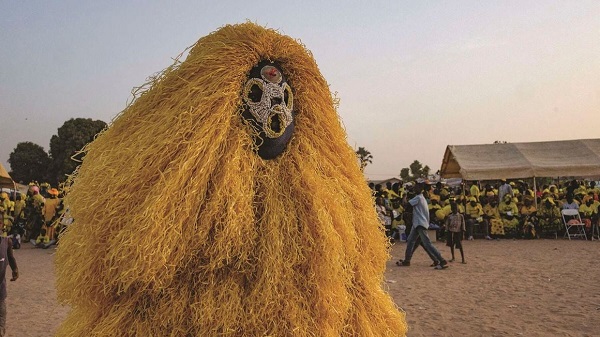| |||||||||
|
|||||||||
|
By:
KEMO CHAM | |||||||||
| Posted:
Jan,18-2023 00:47:47
| |||||||||
When a contestant appeared on the catwalk donning the Kankurang costume during the Miss Gambia 2022 beauty pageant, she sparked heated exchanges, with cultural purists saying the traditional attire should not be worn by women as the regalia is for male circumcision ceremonies.
The costume is part of the Manding or Mande people culture, one of West Africa’s largest ethnic groups. It has often sparked debate on male dominance in cultural practices in the Gambia and Senegal. The Kankurang appears during initiation ceremonies wearing the traditional attire, where circumcised boys are taught cultural practices, including discipline and respect. Gambian commentator on social issues Saikou Camara suggested that Kankurang attire originates from a female tradition that was usurped by the male dominated society.
But this is debatable according to Gambian historian Hassoum Ceesay, who said that while its origin is unclear, it wasn’t wrong for the contestant to wear it during the beauty pageant.
According to Ceesay, there are gender specific costumes in the Mande culture, many of which have been lost to religious influence.
“Just like you can have journalistic licence, the beauty contestant embraced artistic licence. I believe the intention was great. The intention was to showcase our culture and heritage,” Ceesay, who is the Director General of the National Centre for Arts and Culture (NCAC), said on Wednesday.
“I am not sure of the female origin of the Kankurang, but I know in the Manding culture, Kankurang costume is worn during male circumcision ceremonies,” Hassoum told Africa Review.
he Mande is a group of people who speak Manlike, Bambara, Dioula, Soninke, Susu, Ligbi, Vai and Bissa. They are found in Senegal, Gambia, Mali, Guinea, Sierra Leone, Liberia and Cote d'Ivoire.
Besides trade, the Mande are known for their military conquest and control of dominant pre-colonial kingdoms, notably the Ghana empire and Mali empire.
The Kankurang costume is made of leaves and the bark of coloured tree fibre. The wearer carries a machete in one hand and a stick in the other.
The attire is also worn by young boys who are due for circumcision and is believed to guard them against evil spirits while they are being initiated into manhood in a sacred bush.
There are several designs of Kankurang costumes, which signify a specific role. They include the Fara (shredded or torn bark from the camel foot tree) and the Fito (leaf) Kankurang.
A popular design is the Ifangbondi, also known as Wulengo Wulengo, which is thought to be invisible to the human eye and shields the initiates from evil during the initiation period.
Jamba Kankurang is the masked version responsible for making sure that the village is orderly and disciplined.
Kankurangs have also made appearances during festivities like the Muslim feast of Eid, locally known as Koriteh, as well as during Christmas, wedding and naming ceremonies.
Over the years, questions have been raised about the existence of authentic Kankurangs. Reports of people dressing as Kankurang and engaging in criminal activities are now common.
The origin of the Kankurang tradition has been the subject of debate. Some say it originated from the Kaabu empire in the 12th century, while some historians say that it was part of a hunting society which made a contribution towards the emergence of the Manding nation.
The Mande people are predominantly Muslim, which means that a lot of their traditional practices are influenced by Islamic teachings, which frowns at animism.
 A Kankurang-clad dancer at an election rally in Banjul on December 2, 2021. PHOTO | AFP
The Kankurang was listed on UNESCO’s List of Intangible Cultural Heritage in 2005, following concerns of threats posed on it by the rapid urbanisation of most regions of Senegal and Gambia, and the decreasing extent of sacred forests.
The NCAC is an arm of the Ministry of Tourism and Culture, which helped organise the beauty pageant. Ceesay confirmed that his office had received complaints against the contestant donning the costume.
He said that there were several other Gambian traditions exhibited during the night and wondered why this particular one generated so much anger.
Hassoum said they have a plan to prevent the controversy in the future.
“We are thinking of doing something to make sure that in subsequent editions of the beauty pageant, they use the NCAC archives and the National Museum for research on any Gambian culture that they wish to showcase.''
A Kankurang-clad dancer at an election rally in Banjul on December 2, 2021. PHOTO | AFP
The Kankurang was listed on UNESCO’s List of Intangible Cultural Heritage in 2005, following concerns of threats posed on it by the rapid urbanisation of most regions of Senegal and Gambia, and the decreasing extent of sacred forests.
The NCAC is an arm of the Ministry of Tourism and Culture, which helped organise the beauty pageant. Ceesay confirmed that his office had received complaints against the contestant donning the costume.
He said that there were several other Gambian traditions exhibited during the night and wondered why this particular one generated so much anger.
Hassoum said they have a plan to prevent the controversy in the future.
“We are thinking of doing something to make sure that in subsequent editions of the beauty pageant, they use the NCAC archives and the National Museum for research on any Gambian culture that they wish to showcase.''
| |||||||||
|
Source:
The East African
| |||||||||
|
||||||||||||||||||||||||||||||||||||||||||||||||||||||||||||||||||||||||||||||||||||||||||||||||||||||||||||||
|
||||||||||||||||||||||||||||||||||||||||||||||||||||||||||||||||||||||||||||||||||||||||||||||||||||||||||||||


.jpg)




